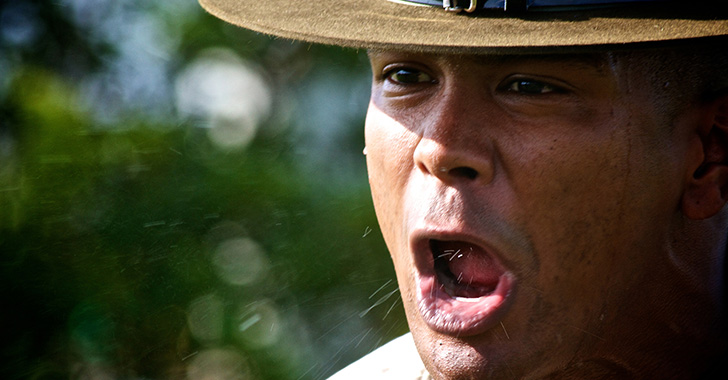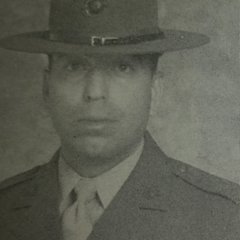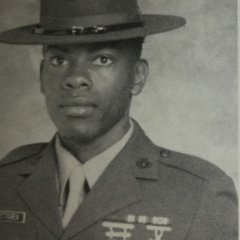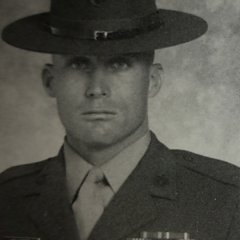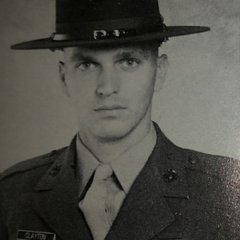My Boot Camp Experience
I went to MCRD San Diego in 1988 and I’m sure many things have changed since then, but here is my boot camp experience, so yes, I’m a “Hollywood” Marine. A long-standing joke in the Corps is that Marines from MCRD San Diego are “Hollywood” Marines and those from MCRD Parris Island are “Fantasy Island” Marines. I was fortunate enough to see both MCRDs up close and personal. Trust me, they both equally suck.
I joined the Corps in the early spring of 1988. I wanted to go right after high school, but I had some loose ends that I needed to tie up before I shipped off, so I enlisted in the Delayed Entry Program (DEP) right after high school graduation. This meant that I signed on the dotted line but was authorized to delay before I went to boot camp.
I and five other ‘poolies’ (a poolie is someone who is in the Delayed Entry Program, meaning they have already signed on the line and are waiting to head off to boot camp) from the area all rode up to the Military Entrance Processing Station (MEPS) center at the same time and stayed the night in an old run-down high-rise hotel. That night was our last taste of freedom, so we snuck out of the hotel (they had a security guard watching the halls) and walked around downtown Detroit somewhere near the People Mover elevated train, which wasn’t a smart idea.
In the morning, we all rode a bus to the MEPS center where we did some physical exams. To be honest this part is almost worse than boot camp for me. There is a group of doctors who do a mass examination of you and the other forty-nine butt-ass naked men in the same room. If you are shy about your body, then this might not be for you. I remember also doing what is known as the duck walk in front of them, so they can see your knees and hips in motion. We all walked around the room doing the duck walk. Once that was all completed, it was off to the airport and before we knew it, we were on an airplane heading to San Diego, CA. For me, this was the very first time I had ever been in an airplane.
Though we were all from northern Ohio, we were sent to San Diego for some reason. Normally, those residing east of the Mississippi River are supposed to go to MCRD Parris Island, South Carolina.
We arrived at San Diego International Airport late in the evening and waited around, sitting in a row on the floor in a segregated part of the airport, waiting for the rest of us to arrive. A few hours later we were told to go outside and wait for the bus. It wasn’t long before a white school bus arrived and we were on our way, heading to MCRD San Diego.
The trip wasn’t long at all as San Diego International Airport and MCRD San Diego share a long fence line, making them neighbors.
When the bus stopped, a tall intimidating Marine entered the bus and shouted:
“Sit Up straight! Get your eyes on me! You are now aboard Marine Corps Recruit Depot San Diego, California, receiving barracks, building 622. The last word out of your mouth will be ‘sir’ and it will be loud! Do you understand? Now when I tell you to get off my bus, you will bring everything off the bus, you brought on the bus, and you’ll get on my yellow footprints. Do you understand? Get off my bus right now!“
It wasn’t long before we were standing on the infamous yellow footprints and started our in-processing. For me the next 13 weeks were not that bad, I was at home with the drill instructors screaming at us all the time as that is the environment I grew up in, so it was like home, lol. I did struggle on some parts of boot camp, mostly the upper body strength things and that was because I was a twig when I joined. I entered boot camp being able to do three pull-ups and left doing twenty and I maintained that standard all through my Marine Corps career.
The next sleepless 36-plus hours are spent at the receiving side of MCRD, and that consists of getting off the bus, learning about the Uniform Code of Military Justice (UCMJ), and paperwork, receiving your uniforms, and learning how to do the basics, shower, shave, brush your teeth before you are sent to your training platoon.
In the receiving barracks, we seemed to flow from one minor task to another. We spent time stenciling our names on our uniforms, then it was off to take a piss test (urinalysis), then we learned how to put on and lace our boots. They are all small tasks, but they consume time when you are trying to get eighty young males to do it all correctly.
Receiving usually starts with what is called the “amnesty room”, where you are to surrender all items that are contraband as well as start the process of getting your personal belongings into storage and start receiving your first issue of gear. In the amnesty room, there is a swarm of drill instructors who are pacing back and forth, while you are given detailed instructions, then you are to follow those instructions as drill instructors look over your shoulder. When it happened to me, it wasn’t so funny, but today, it is a riot to watch. The look on the faces of some of the young males is classic.
This is recruit (Last Name)
I have arrived safely at MCRD San Diego.
Please do not send any food or bulky items.
I will contact you in 7 to 9 days via postcard with my new mailing address.
Thank you for your support. Goodbye for now.
{CLICK}
After your phone call, it is time to get a haircut. I’m not talking about a little trim, nope, I’m talking bald baby. Then it is time to go into a large room, where you will receive your welcome briefing, which covers rules and processes and what to expect. Then it is off to the receiving barracks.
While in the receiving barracks, you learn how to take a shower the Marine Corps way, you put your name and platoon number on all your gear and uniform. You are up for 36 hours intentionally, and you spend that time learning how to do the things that get you through boot camp, so the real training. The receiving drill instructors are mostly all about business and not screaming and yelling at you. You need to know the stuff they are teaching you and you need to master it in a short time. You don’t get much sleep in receiving, you are awake for the first 36 hours, again by design.
If you check out the 1989 “Earning the Title” video, you see that though there is a ton of yelling, you notice that the instructors are there for training and education, it is this where the Drill Instructors shine. If you watch the video and at the 16:09 mark you notice that their Senior Drill Instructor uses his skills to motivate his recruits. In the Confidence Course part of the video (16:55) you watch the Drill Instructors help the recruits get over their fear of heights and provide them with knowledge on how to complete the task. There is not that much yelling going on, it just depends on the part of the training schedule and who the recruit is, sometimes.
Training Phrase 1
Training Phase 1 starts, after receiving it is time to go to your barracks and meet your drill instructors. They will teach you everything you need to know to get through boot camp and earn the title of U.S. Marine.
I was assigned to platoon 1030, Charlie Company. We started with around eighty recruits, and four drill instructions (GySgt Hernandez, SSgt Pettegrew, Sgt Van Orden, Sgt Clayton) Our first senior drill instructor was with us for a few weeks before he left us, which is not normal. He was a huge muscle bound Marine and the day he left, he called us all to the quarterdeck (the front of the barracks) and told us about the Marine Corps height and weight standards, and that he was no longer within those standards to be a drill instructor and he could no longer get a waiver, so he was being removed from being a drill instructor. The whole situation made me sick to my stomach as I was on a weight waiver myself, but for being too skinny. I was 6′ and something like 145 pounds. For GySgt Hernandez, there wasn’t any fat, he was all lean muscle, and you would think that the Corps would want that. GySgt Hernandez was replaced by SSgt Atondo, who was known for how well he taught close-order drill.
My rackmate was Ralph Breceda. I slept on the top and he was on the bottom, and no, you don’t get to choose. Strangely I have never run into him or anyone else from my platoon. But a quick Google search reveals that he left the Marine Corps in 1992 as an LCpl. And well, it isn’t true that I haven’t run into anyone, there was this one guy who claimed he was in my platoon, and that he was the lay leader, but I don’t remember him, and he didn’t graduate with us. He told me this whole story about him in our platoon, but I still didn’t recall him.
Boot camp wasn’t always a bunch of yelling and screaming, there is a ton of education and physical training (PT) also, but mostly it was learning how to follow orders and do things a certain way. One of the first PT things we did was our Initial Strength Test (IST) which is designed to track our physical progress through boot camp. We took another strength test later.
We also get to go to the pool, but it isn’t what you think it is. The swim qualification is designed to make sure every Marine can swim in a rescue situation. You end up doing most everything in the pool in full combat gear. And if you can’t swim, they will train you. Once the swim quals are done, another big PT aspect of boot camp is the Confidence Course and the Obstacle course. The Marine Corps understands that many people have a fear of heights, a fear of swimming, and other fears. Any time there is a fear like that, a drill instructor pulls that recruit aside and patiently works with them. They know that you can’t yell a recruit into doing something like that as fear will win out. They also never threaten to kick you out in a situation like that. Most of the time they can help you work through those fears and help get you past that obstacle and pass that fear. This stands out in the “Earning the Title” video, where the drill instructors are talking to the recruit about their fear of heights.
The obstacle course is a timed event, and we are competing against others, whereas the Confidence Course is made up of large obstacles that help build your confidence. One of the obstacles is called the Stairway to Heaven and it is a 30-foot-tall ladder that you climb and go over the top and climb down. There is a scene in Full Metal Jacket that features the Stairway to Heaven, I’m told that the Stairway to Heaven has either been renamed or removed from the course.
Another big obstacle is the Slide for Life, which is very demanding both mentally and physically.
Here is a good video showing many of the fifteen obstacles in the confidence course. You will also notice that the drill instructors are not yelling and screaming at the recruits as this course is already stressful enough for many recruits.
For me, the biggest problem that I had was io the confidence course was the ‘Slide for Life’, specifically the part where you must pull yourself back up to the rope. I worked my ass off in boot camp to build a stronger core and upper body strength, as I wasn’t going to let the only obstacle that I couldn’t master, kick my ass again. We ran the course again, in the third phase and I was halfway down the rope slide when the drill instructor ordered us all to hang by our right arm and then he ordered “Hand Salute” and down I and the other two recruits on the rope went, into the murky water. I was so pissed, but there wasn’t anything I could do, besides follow orders. It is my understanding that there is now a net over the water, so you don’t fall into the water any longer for some reason.
I also struggled with the first round using the Pugil sticks, as that was something new for me and something I didn’t have the technical knowledge to do correctly. I had only been in a couple of fistfights when I was younger, so the whole concept was foreign to me. I was a wrestler in high school, and I’m one of those people who need to know the technical aspects of things, so I pretty much sucked at it. The first time I got smashed in the face right away and that knocked me over and that was all she wrote. Depending on the instructors, you may not be given an opportunity to stand up and go again. The second time was the “Bridge Over Troubled Waters”, where you fight with the pugil sticks while standing on a telephone pole. I intended to go out swinging, but the moose I was put up against, used his larger size and just ran into me with his body, and down I went, he never swung his pugil stick once. He was told to go again, and I didn’t have that same opportunity. I did have an opportunity to use them once more while in the Corps and that time I was much more successful.
Back in the eighties, you did your laundry on a wash rack, at least some of your laundry. I recall the entire platoon using the wash rack that was behind the barracks. But I also recall sending some laundry out to be cleaned, we would stuff it into our laundry bag, and off it went. I believe now the recruits have access to a washing machine to do their laundry.
I personally, along with one other recruit from my platoon was selected for what is called Special Screening, which is where based on your GT score (your GT score on ASVAB tests is the sum of three ASVAB score results and is a loose translation of your IQ score) and aptitude, you are selected for additional testing and screening. You are screened for special duty assignments, such as any of the Intelligence MOSs. The Marine Corps has many opportunities, if you can demonstrate that you are above the average Marine. MOSs that require a Top-Secret security clearance is one example. If you stay a career Marine (re-enlist at least once), then you might be able to get screened for independent duties, instructor billets or even screening for a MARSOC billet, just to name a few. The Corps is always on the lookout for those that exceed.
I remember that on Sunday it was church time, even if you weren’t religious, it also meant that the drill instructors were not allowed to make you dig in the sand pit. Outside each of the barracks and many other places on base are these large sandboxes. They are made for what is known as IPT, which is, a time when the drill instructor takes individuals to the sandbox, or the entire platoon, and they “make it rain” sand. You will do a series of exercises that suck extra in the sand, lol.
But on Sunday they are not supposed to take anyone to the sandbox. So, they would have us close all the windows in the barracks (no A/C) and have us move all the racks (beds) to one side of the barracks, a game they called “squadbay east and squadbay west”. Then they will IPT us in the closed-up squad bay. I think that sucked worse than the pit because the heat built up quickly. I was used to the high heat and humidity, being in wrestling, but when they were finished IPTing us for a good 15-20 minutes, the deck (floor) of the squad bay looked like someone turned on a garden hose and sprayed down the deck.
As a recruit, you will see all this as punishment, but it is all designed to build you into a Marine. When you get on the other side of things and look at it from that POV, you realize what they are trying to do. The entire goal of boot camp is to break you down from who you were and rebuild you in the Marine Corps way to be a U.S. Marine.
In the evening, you have a brief period where you need to shower, shave, use the head (toilet), and get your gear ready for tomorrow and then you can write a letter or in some cases quietly socialize with your neighbor. But honestly, the spare time is usually consumed by getting everything ready for the next day. Our barracks faced the airport, so all night long we got to see freedom so close, yet so far away.
Training Phase 2
Phase two started with the entire company (six platoons of 60-80 recruits) getting on buses and going to Camp Pendleton – Edson Range, which is about an hour’s trip in all. The entire training company was sent, which was six platoons of recruits. Here we will start the second phase of training, which is the rifle range, Mess and Maintenance, and Basic Combat Training. We get assigned to a new barracks and move in; we will spend the next four weeks here. We started with a few long humps (hikes), the gas chamber, which isn’t that bad at all. After my ten years in the Corps, I had grown fairly accustomed to the smell of CS gas, and though it is annoying, it isn’t that bad, just don’t touch your face. We also run through simulated combat courses and fire a wide variety of weapons, including the AT-4, M249, M203, and 50-Cal, we also learn to throw grenades as well.
Then it is time to start working with our rifle.
We get a week of snapping in, where you practice shooting the rifle. I know it sounds silly, but it works. We practice aiming at 55-gallon drums, painted white with small black targets, about the size of that the target would look like at the 200–300-yard line. And then you head to the rifle range for live fire. Half of the recruits were shooting, and the other half was down range, pulling and scoring targets, which is known as working the butts.
After rifle qualifications on Friday, it was a 15+ mile forced march from Edson Range for the Basic Combat Training.
Edson Range - Camp Pendleton, CA
It was referred to as the “Death March” by some of the salty Drill Instructors and took us up along ‘Bitch Ridge‘ and up ‘Mount Motherfucker‘. I recall stopping once for a break, to eat, and change socks, and some officer who was humping with us, was telling us some war stories while we ate. The overall environment was rather chill compared to what we have been experiencing to this point. The entire attitude of the drill instructors changed when we arrived at Camp Pendleton. This is by design, as yelling and screaming isn’t a good environment to learn skills like shooting, and combat skills. So, everything is toned down a little.
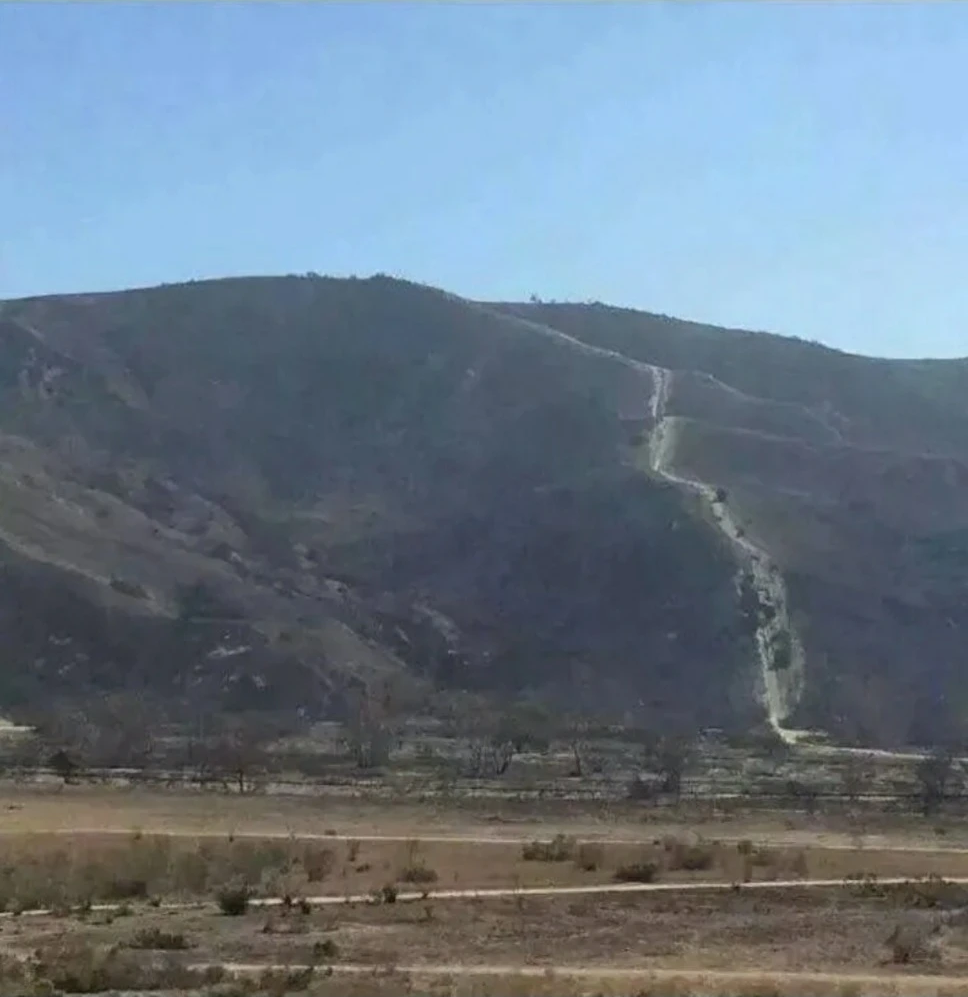
We were carrying antique ALICE packs on our backs, filled with an extra set of cammies, extra set of boots, shaving and shower gear, shelter half, sleeping gear and bag, an MRE and water, and whatever they could have our stuff in them for weight, weighing in somewhere around 70-80 pounds and rifle. This isn’t much, but if you have never hiked before, this all combined can be a killer. Before this hump, this was a new experience for me.
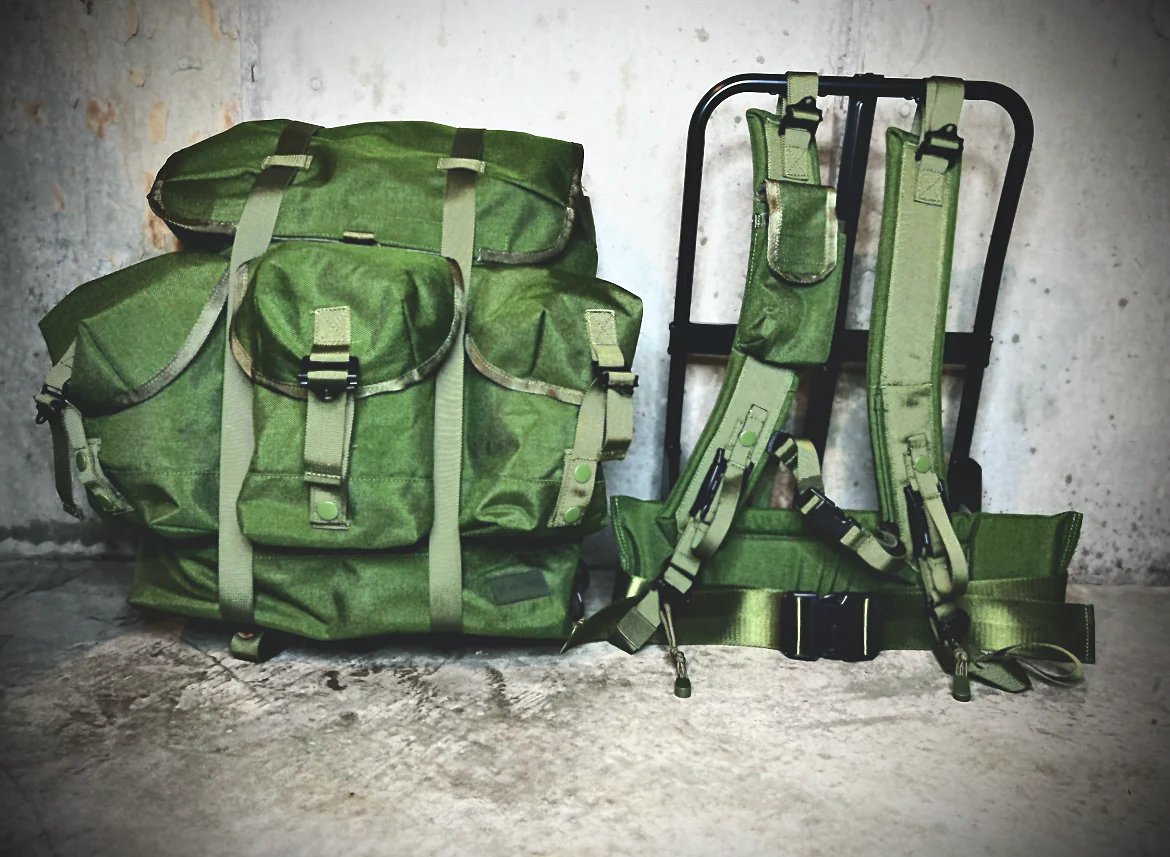
So what is this talk about Mount Motherfucker? Mount Motherfucker is located off San Mateo Drive, Camp San Onofre. It is at the last stage of the 15-mile hump from Edson Range. Mount Motherfucker is also known as Old Smokey but is often confused with 1st Sgts Hill, which has a memorial to fallen warriors (5th Regiment Memorial) at the top and is located to the west (about two miles) of Mount Motherfucker. It is also often confused with the 700′ high Reaper or Grim Reaper which is near Range 131, just 2.6 miles to the north of the Edson Range grinder/parade deck. Sadly today, the trail up Mount Motherfucker serves as a fire break and not much more.
In 1996, the training program for new Marines at MCRD San Diego went through a drastic change. This was the start of the 54-hour field event, known as the crucible. The crucible is held near Edson Range (about 1.5 miles to the east). Part of the crucible is a 9.7-mile hike that includes the Reaper. Recruits no longer climb Mount Motherfucker since the start of the crucible being added to the training matrix in training week ten. If you want to learn more about the USMC Recruit Training Matrix, you can see updated copies for both Parris Island and San Diego.
However, we can rest assured that they are still building tough Marines, as today, they run The Crucible which is a 54-hour event, in which the recruits get three MREs, 8 hours of sleep over the two-and-a-half-day event and hump some forty-five miles in total carrying a 55-pound pack. Since early 2021, both male and female Marines have completed the same events at both recruit depots.
Fun Fact, Edson Range is named after Medal of Honor recipient Col. Merrit A. Edson. During the battle of Guadalcanal, Edson’s Raider Battalion, consisting of two companies from the 1st Parachute Battalion, was guarding an airfield when they were attacked by Japanese forces. Under Edson’s leadership where he was encouraging, cajoling, and correcting as he continually exposed himself to enemy fire, his eight hundred Marines withstood the repeated assaults of more than 2,500 Japanese soldiers. Edson was later awarded the Medal of Honor for his honor, courage, and commitment.
Every Marine has a good story about their time at boot camp. Mine was while we were running through the night infiltration course. My platoon is moving through a dry riverbed or something like that in the cover of darkness, with overhead illumination rounds being shot overhead. I was right next to one of our drill instructors. He signaled for us to stop, which meant that we stopped and got down on one knee, as he saw something. We did as instructed and about two or three seconds later, there was a pop like a firecracker going off. The instructors or it was someone from safety, I don’t know, heard it, and called for the lights and these bright ass lights come on and they wanted to find the source of the sound. I was right next to a Drill Instructor, who had a little blood running down his face from a fresh wound. He looked at me and I had blood on my face, my left arm, and my left hand. Nothing big, just some fresh blood from fresh wounds. We all stood up and I had blood all over my knee on my left side.
Come to find out, when we were told to stop and kneel, I kneeled on the fuse of a hand grenade that was not supposed to be out there.
Inside a grenade, is a fuse, which is similar to a firecracker, wrapped in aluminum about the thickness of a soda can. When the fuse went off, the shards of aluminum went into my skin as well as my drill instructor. I was preparing to get a thrashing for this, even though I had zero control over it. I was shocked when they called a safety stand down. Everyone around the two of us was told to go to a rallying point, EOD came to the two of us observed the area, and then escorted us to a CUCV (Commercial Utility Cargo Vehicle, a.k.a. a pickup truck) I couldn’t get the whole story, but from what I was told, hand grenades were not supposed to be in that area and most definitely, not just a fuse laying around. I’m still not sure how it tripped, as one would think it had a pin in it, but it was lying on the ground in such a way, who knows.
I was seen by the Corpsman, as was the Drill Instructor, and then we were both shuttled back to some building, no clue where, and together seen by an officer, I couldn’t tell you the rank, I was too scared. We had to write a statement, then we were sent back to our platoon and that was the end of it, or at least the end of it as I know it to be. I never received any type of thrashing for it, which was shocking to me at the time. I was visited by a corpsman in the morning and again that evening to change my bandages. The wounds were nothing at all, but they seemed to care about them.
After field training, we moved to either working in the mess hall or you are assigned maintenance (yard work, painting, things like that). One platoon gets split in half and the two halves are assigned to other platoons for the week. Our platoon was that platoon. The platoon that I was assigned to was very childish and there was a ton of infighting amongst themselves, the Drill Instructors were always putting them in the pits (sandbox) to dig. At night they were beating on other recruits, none of that crap was going on in our platoon.
It was only for a week, so we toughed it out, but when I got back to our platoon and barracks, the drill instructor found my rifle unlocked, which was a HUGE problem. All the rifles were left with other recruits who didn’t go to other platoons. They found mine and another recruit’s rifle unlocked. I got a major ass-chewing for that and had to dig for a while. The sad part is I hadn’t seen my rifle in a week. We had to give them to the other recruit unlocked and he just had not locked some. Oh well, no harm, no foul.
Training Phase 3
We were starting to jell as a platoon and the drill instructors were not as in your face as much from that point on. It also helps that by this time, most of the screw-ups have been removed from the platoon and all that remains are those who want to become Marines. We still had a ton of physical training to do and more education, but it all seemed very routine at this point. Gone were the days when someone was out of step or didn’t know their right from their left and stops to the pit were not as often.
We had a ton of inspections, all preparing for our final inspection. While on active duty, you don’t stand a ton of inspections, but in boot camp, we had them all the time. They were to not only train us for inspections in the fleet but also to make sure we knew how to wear our uniforms and understood the knowledge that was pumped into our heads. As a recruit, you will feel like every Marine on the base has it out for you, and that isn’t the case. They don’t care about Joe Average; they simply care about making me and all the other recruits the best Marines we can be. As in the fleet, we will be serving next to them and if they didn’t do their job and weed out those that can’t cut it, then I could get hurt or killed on the battlefield.
I remember that mail-call was an important thing in boot camp, and there was always one or two recruits whose parents sent him a care package, which of course they were not allowed to keep much of it. They had to open it on the quarterdeck in front of the drill instructor. If you received a picture of your girlfriend or wife, the picture was placed on a whiteboard, called the “Hog Board” and everyone could see the photo and it had to stay there the entire time. I’m sure that things like the “Hog Board” are not PC so they aren’t done today, but I might be wrong.
In the eighties, which was before the Corps started the ‘Crucible’, we had Visitors Sunday and Graduation a few days later. We also graduated in Alphas as we weren’t issued Dress Blues, which was reserved for the honor recruits, the recruit from each platoon who was the platoon guide. They usually got a meritorious promotion out of it. I remember thinking to myself in boot camp how lucky they were to get PFC out of boot camp, but if you are a good Marine, then you will be able to pick up PFC in three months (6-months’ Time in Server, but time in boot camp counts).
My parents came to visit me on “visitors” Sunday and my graduation. For graduation, my parents were there as well as my high-school sweetheart. After graduation, we all drove back from California to Ohio. That first evening, I proposed to my high-school sweetheart and I’m happy to say that we recently celebrated 35 years of marriage.
I was home for a week before I had to report to my “A” school. Back in the eighties, we didn’t go to MCT like new Marines do today.
I never ran into any of my drill instructors or anyone from my platoon while I was in the Corps (except for the other Marine who was selected for special screening from my platoon). I did find this video when doing research for this video of Sgt Van Orden and another platoon at MCRD.
Welcome to the Average Joe Weekly blog. This is basically my place on the web where I can help spread some of the knowledge that I have accumulated over the years. I served 10+ years in the Marine Corps on Active Duty, but that was some 25 years ago.

